In January 2013, Rob Rhinehart stopped eating food. Or so he wrote in his blog post thirty days into the experiment. His idea was to compile the bare nutritional elements of food into a synthetic liquid. Why? Freedom from the time and effort of having to procure meals and even chew them. Getting the fuel mix just right so that you maximize energy and lose weight. No impurities or contaminants which might be triggering your hidden immune reactions or making your gut leak. And maybe super cheap. It was the future. There was some press coverage [1] and Rob went on to start a VC-funded company to make and sell product.
I’d played around with recipes for “energy bars” over time, so when I read about this idea my first thought was: This is the logical conclusion of any such effort! So I immediately set out to make my own version of soylent. I ordered the DRI Book and started pulling together ingredients. I will share my formula below for the sake of collective knowledge.
I encountered some problems with soylent that soured me on the whole idea after a month or so. I will explain those below after the formula. Maybe the company has a way to solve these problems, or maybe (probably) there is a customer segment that feels differently.
Formula
Obligatory disclaimer: This formula is provided for informational purposes only and I can take no responsibility for any results if you use it.
There are three classes of ingredients in soylent: macronutrients (many grams per day required); what I call “medionutrients” (between 0.5 and 5 grams per day); and micronutrients (milligrams or micrograms per day). My formula sources micronutrients from a multivitamin, and uses powders for the macro- and medionutrients. This isn’t perfect because multivitamins rarely have exactly the daily recommended amounts of all the micronutrients, but it saved a lot of work and expense for the purposes of a trial.
For balancing macronutrients, I recommend the free web app Cronometer. It helps you get a specific nutrient ratio while hitting a target number of calories, so that you know how much of each ingredient to add.
Macronutrients
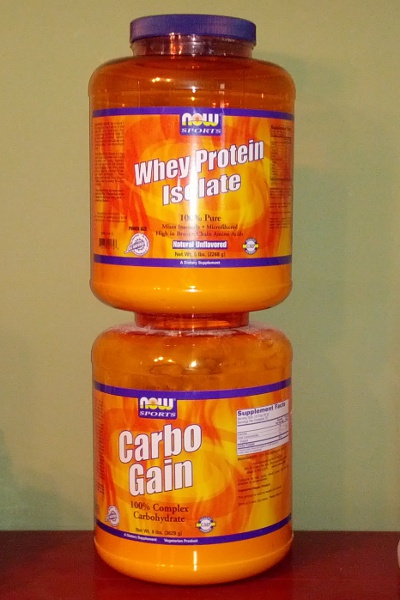
Macronutrients are carbohydrate (including fiber), protein, and fat.
The main ingredient in soylent is maltodextrin, which is a short-chain starch. I tried alternatives like corn or potato starch, or waxy maize, and those all tasted chalky. I also tried dextrose, but it was too sweet. The only other thing that seemed to work was using some amount of oat flour, but this required adjusting all three macronutrients (fairly easy to do in Cronometer). I enjoyed the flavor of the oat flour but it tended to get stuck in my coffee mug spout, and besides it felt like “cheating” because the whole point of soylent was not to be based on food (for example, what if the phytate in the oats blocked absorption of some of the nutrients?) So, maltodextrin is the main thing. Link to CarboGain maltodextrin on Amazon.
For protein powder, I tried several kinds (collagen, soy, egg white, whey) and whey protein tasted by far the best. I aimed for 10-15% of calories from protein, based on the DRI which recommended 0.66 g/kg/day for my age and sex, which works out to 10% of calories for a 60kg person consuming 1500 calories a day. I tried higher proportions of protein but never really noticed a difference. Link to whey protein powder on Amazon.
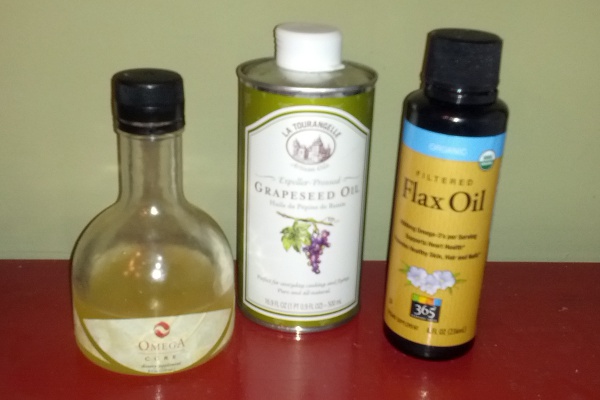
For fat, only a few grams are needed each of linoleic (omega-6) and alpha-linolenic (omega-3) acid. According to Stephen Cunnane, the official DRI requirements for omega-6 are overstated by 5 to 15 times, so I didn’t worry about meeting the full omega-6 requirement. Originally, I used flax oil for omega-3, but then got my hands on some fresh fish oil called Omega Cure (not fishy tasting!), which I began using instead. For omega-6, I used grapeseed oil, but whenever my formula replaced some of the maltodextrin with oat flour, that usually provided plenty of omega-6 without additional oil. I generally kept my fat to 10-12% of calories, which was more than enough to cover the fatty acid requirements. Because of the use of phosphatidylcholine from lecithin (details below), I never had any trouble emulsifying the oil into the drink. I did experiment with higher proportions of oil; I tried going up to 30% and more calories from fat, from such sources as MCT oil and olive oil, but the higher-fat formulas usually made me feel queasy and did not seem to slow gastric emptying or improve satiety at all.
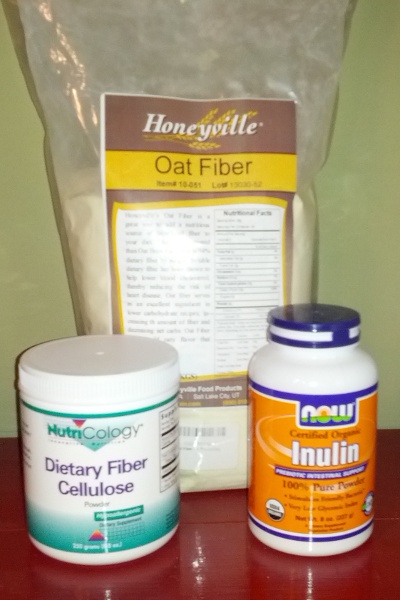
For fiber, I tried a few different kinds. Inulin and oat fiber were both agreeable in that they are mostly soluble fiber, so they dissolved. Psyllium husk powder was OK, but not as good. I failed to find a reasonable source of insoluble fiber — I didn’t want to use bran (trying to avoid grain products due to possible antinutrients), and cellulose powder was grainy and tended to settle out. I later read that xanthan gum can be used to suspend insoluble particles, so if I were to give it another go, I’d try that.
Finally, water. For my daily ration I tended to make enough soylent to fill three 20-oz travel coffee mugs. I drank these over the course of the workday: one in the morning, one around lunchtime, and one in the late afternoon. 3 cups of water was about the right amount of liquid to add for this volume. This also produced an acceptable consistency in conjunction with the soluble fiber acting as a thickener. I did find that I needed to drink additional water during the course of the day.
Summary of macronutrients: For a 1500 calorie drink,
| Nutrient | DRI requirement | Source | Amount |
|---|---|---|---|
Carbohydrate |
N/A |
Maltodextrin |
300 g |
Protein |
0.66 g/kg |
Whey protein |
50 g |
Omega-3 fatty acid |
1.1-1.6 g |
Flax or fish oil |
1 tsp (5 g) |
Omega-6 fatty acid |
12-17 g |
Grapeseed or soybean oil |
2 tsp (10 g) |
Fiber |
14 g |
Oat fiber or inulin |
15 g |
Water |
N/A |
filtered water |
3 cups |
Medionutrients
The “medionutrients” (my made-up word) are potassium, calcium, magnesium, sodium, phosphorus, and choline. You need less of these than macronutrients, but they are still measured in grams instead of milligrams as for most micronutrients.
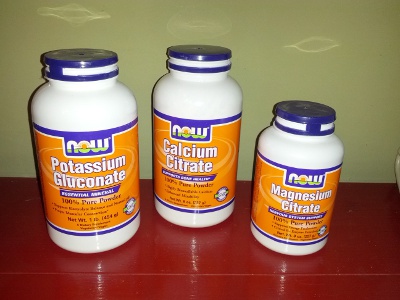
Potassium chloride, though the form of potassium most commonly used in hospitals to address a deficiency, also tastes strongly metallic. I found potassium citrate to be somewhat sour. The most neutral form I tried was potassium gluconate, so that is the one I used. Note that, as explained in the DRI book, an important function of dietary potassium is neutralizing diet-derived acids such as those from protein intake, so the accompanying cation is an important factor; it needs to be a bicarbonate precursor such as citrate, gluconate, or acetate, whereas chloride is specifically unsuitable. A bit of high school chemistry math was used to determine how much potassium gluconate is needed to provide the required amount of elemental potassium.[2] Also, it is crucial to get the powder form, because there is some legal requirement that potassium supplements in tablet or capsule form can have no more than 100 mg of potassium each, which is well below a tenth of the daily requirement. Link to potassium gluconate powder on Amazon.
I shied away from calcium carbonate due to the chalky texture and lesser bioavailability compared to calcium citrate. I also found the citrate form to work fine for magnesium. Links to calcium citrate powder and magnesium citrate powder on Amazon.
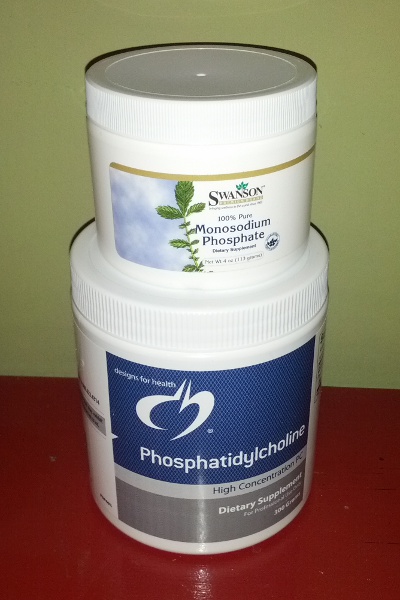
Phosphorus, choline, and sodium were a little trickier. I started by nailing down the choline source. I skipped over choline bitartrate because according to reviews, it tastes terrible. The two forms that I tried were citicoline powder, pictured below with the spirulina, and phosphatidylcholine (PC). The citicoline had an unpleasant taste and it was also quite expensive, whereas the phosphatidylcholine from lecithin concentrate had a neutral taste and also carried the benefit of being an emulsifier. In addition, I’d read this article about potential nootropic benefits of PC, and as a result I chose to use about double the DRI of choline in my formula. To calculate the total molecular weight of PC, I assumed one oleic acid and one stearic acid, based on the fatty acid composition of soy, since the lecithin was soy derived. This gave a molecular weight of 808.164 for PC, which means 1 g PC provides 129 mg choline and 38.3 mg phosphorus. Since the lecithin concentrate consisted of 40% PC, 19.4 g of the powder is needed for 1 g of choline.
PC contains phosphorus, so it was necessary to subtract that out from the total phosphorus requirement in order to calculate the proper amount of monosodium phosphate.
Finally, MSP contains sodium, so that needed to be subtracted out of the total sodium requirement in order to determine how much table salt to add.
It is possible to weigh macronutrients with a regular food scale, but for the “medionutrients,” you really need a scale with tenth-of-a-gram accuracy. Fortunately, quite good ones are available for around $10. You will probably also need weighing paper.
The final mix:
| Nutrient | DRI requirement | Source | Amount |
|---|---|---|---|
Potassium |
4.7 g |
potassium gluconate |
30 g |
Calcium |
1 g |
calcium citrate |
4.75 g |
Magnesium |
320-420 mg |
magnesium citrate |
2.4 g |
Choline |
425-550 mg |
phosphatidyl choline 40% |
20 g |
Phosphorus |
700 mg |
monosodium phosphate |
2.8 g |
Sodium |
1.5 g |
sodium chloride (table salt) |
2 g |
Micronutrients and Extras
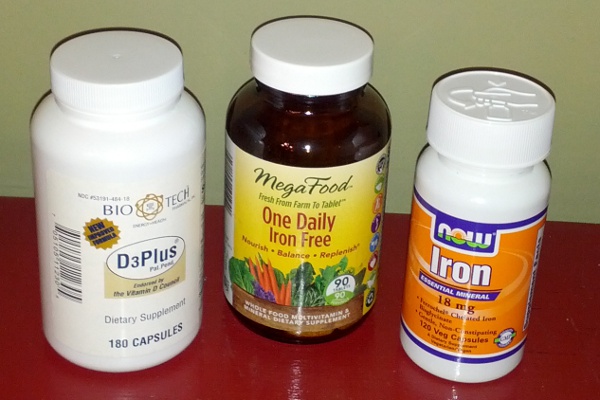
For micronutrients, I used a multivitamin, and my go-to was MegaFood. One reason I like this brand is because it is one of only two brands of vitamins that I’ve tried which don’t seem to cause vitamin burps, even if taken on an empty stomach (the other brand is New Chapter). I took two “once daily” tablets. The multivitamin I had on hand was an iron-free form, so I took iron in a separate supplement. Finally, I took additional Vitamin D3. I like to take 5000 IU per day, because I live in Seattle and I don’t get outside much. The D3 pictured here happens to be one that came with additional magnesium and other vitamins, which were unnecessary — my preferred D supplement is this one.
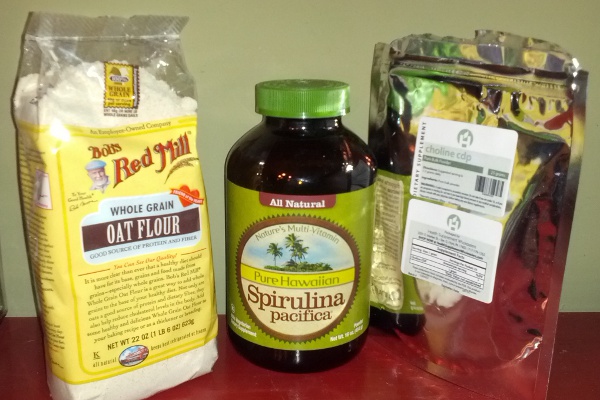
Here I’ve pictured some odds and ends. I mentioned above that I sometimes used oat flour to substitute for some of the macronutrients. Sometimes I added spirulina for the phytonutrients, and also because this let me call it “soylent green”!!! Haha.
Why I Don’t Recommend Soylent
Satiety
The biggest problem that I had with soylent was that it was not satisfying. All of Rob R.’s posts gushed about how satisfying it is, and apparently he went through a whole round of trials in which people loved it and found it perfectly satisfying, but I did not find this. I varied all of the macronutrients every which way, and could not fix this problem. Generally, I could get through a work day just fine with 1500 calories’ worth of soylent for breakfast, lunch, and late afternoon “dinner,” but by the time I got home I was ravenous for something solid. I was not opposed to eating some solid food in the evening for pleasure if not for necessity, but the problem was, I had such an appetite at that point that I usually well overshot my calorie target for the day, taking into account the 1500 calories I’d already consumed. (I’m a smallish woman, so my calorie budget is rarely more than 1800.) For the most part I especially seemed to crave starchy things, such as bread, and as a result, part way through my experiment I decided to give up wheat because I thought I might have uncovered a hidden wheat addiction. (I later decided this effect was actually a result of the refined carb maltodextrin leading to a craving for white flour, i.e. more refined carbs. When I switched to whole grains, this problem seemed to go away.)
In search of an explanation for my satiety problems I dove into PubMed, and was surprised to uncover a pile of research about the effects of food viscosity on satiety in both rats and humans. The consistent result from dozens of studies: liquid food is not satisfying. In all cases I saw, calories in liquid form led to overconsumption of total calories (i.e., hyperphagia).
-
Beverage viscosity is inversely related to postprandial hunger in humans. (2001)
-
Carbohydrate-induced hyperphagia and obesity in the rat: effects of saccharide type, form, and taste (1987)
-
Liquid versus solid carbohydrate: effects on food intake and body weight (2000)
-
Food viscosity influences caloric intake compensation and body weight in rats. (2005)
It’s not about fiber content: in this study (“Feeding a liquid diet increases energy intake, weight gain and body fat in rats”), they pureed regular rat chow with water and observed the same effect.
It’s not about palatability: in this study (“Overeating, overweight and obesity induced by an unpreferred diet”), they added something to the liquid diet that made the rats dislike the taste compared to solid food, but when fed this solution alone, they still gained weight.
It’s not about carbohydrate per se: in this study (“Obesity by choice revisited: effects of food availability, flavor variety and nutrient composition on energy intake”, experiment 3B), an emulsified high-fat milk-like solution (higher energy density) prompted higher consumption, and more weight gain, than the sucrose solution.
It might be about “bite size” and effort required to consume: The effects of food viscosity on bite size, bite effort and food intake. This could explain why hot soups are usually satisfying. We tend to eat them slowly and “chew” them. I tried this with the soylent but it was kind of gross, like swishing with a milky mouthwash.
To be fair, most of the studies were done in animals, but there were enough human ones that the relevance of the animal research seemed to be supported. All in all, I found ample explanation for my subjective experience that soylent was not satisfying.
But, I mean, if it works for you, that’s great.
A Bit of a Gamble
The second problem is that it is unavoidably a health gamble. We humans do know an impressive amount about our nutritional requirements. If you thumb through the DRI book, you can’t help but think, “Wow, we sure are clever to have figured all this out!”
But here is an example of something that is not well known. Folic acid is a synthetic form of folate, a B vitamin. This nutrient is crucial for expecting mothers, to prevent issues like neural tube defects in the fetus. Folate is abundant in green leafy vegetables and beans but many women don’t consume a lot of vegetables. As a result, folic acid supplements have been strongly promoted, and some foods have been fortified with folic acid. Here’s the problem. Folic acid has to be converted to a bioactive form: the usable form is tetrahydrofolate, a.k.a. folinic acid, or — after a methyl group has been added — methylfolate. Everyone has a metabolic bottleneck limiting how much folic acid they can convert into folinic acid, which means that unconverted folic acid may wind up stranded in the blood. In addition, some significant proportion of the population lacks the ability to convert folic acid into folinic acid at all. The trouble with all of this? Circulating folic acid has been linked to elevated cancer risk. Someone making soylent could easily use folic acid because it is cheap, available, and the risk is not widely known. And this is just one example.
As another case in point, Rob R.’s three-month update describes the sudden appearance of a deficiency in a previously unconsidered nutrient, sulfur. He added methylsulfonylmethane to his formula and states in his post, “I have not experienced any other deficiency symptoms and am quite confident I am now getting everything I need, but I will keep testing.” OK, good luck with that. Vitamin B12 deficiencies can take 10+ years to show up. (Anyway, this anecdote is puzzling. I thought he was using whey protein and isn’t that a good source of sulfur?)
Convenience
The third problem I found with soylent: Not Actually That Convenient. I had to measure the ingredients every day; of course if I’d stuck with it I could have pre-mixed a single powder and then had only one thing to measure. Then, a blender was required to properly constitute the liquid. This was inconvenient for working in an office. I tried Blender Bottles but they are noisy, and I didn’t want to add a blender to the office kitchen, so I always had to plan ahead carefully for the day. And if I didn’t drink the soylent (or clean the blender jar and travel mugs) within 12 hours, it fermented impressively fast. Rotted, stinky soylent leftovers were actually a huge nuisance. It was not exactly the pristine cyborg experience that I was hoping for.
Gone With the Wind
Finally, there were some ripe farts. I wasn’t alone. Apparently, the Soylent company addressed these issues in v1.1 by adding enzymes and in v1.4 by decreasing protein, soluble fiber, and complex carbohydrates. But reports of stinky gas persisted for version 1.5+. Based on my own experiments, I pinned the blame on the following factors: (1) the use of high-sulfur-amino-acid protein supplements like whey (protein farts appear to be a known phenomenon); and (2) bypassing chewing, which means failing to mix salivary enzymes with the complex carbohydrates. The most straightforward way of dealing with these issues seemed to me to be… eating intact food.
Retrospective
Did I experience the intense euphoria and extreme mental clarity that Rob wrote about? In the very beginning, I got a taste of it. In that first week or so I was full of excitement for the new idea and I felt euphoric after consuming the drink, and a little anxious when I needed a hit and couldn’t get some right away. I was convinced that all those nutritional components were nourishing in a really important way. But after the first week or two that effect waned, and pretty soon it was just an energy source. One benefit I did notice was that I didn’t feel heavy or sleepy after a soylent meal. But I think this can be explained by the low calorie load per serving.
Having come to this perspective, I’m left wondering what soylent is offering that other liquid diets aren’t. Ensure, Slim-Fast, Isagenix, and others already exist. I think the real selling point is Rob’s enthusiasm and his subjective experience of improved well-being and performance through optimal nutrition. I think we all want a piece of that. Who wouldn’t?
My soylent experience wound up reinforcing the value of whole food. Refined maltodextrin caused me to crave more carbohydrates, so I turned to intact grains and high-fiber starchy vegetables. Liquid calories were unsatisfying, so I stuck to whole fruit instead of juices. Oil was unpalatable when consumed in a drink, so it strengthened my resolve to avoid pressed oils, and stick to nuts and seeds that are whole or at least ground into paste. If adequate potassium, folate, and carotenoids are good, nutrient complexes from vegetables like spinach and kale are worth leveraging. And a diet of mostly plants is almost like deriving sustenance directly from a mineral source; it’s compliant with the principle of relying on stuff that is abundant and low on the food chain.
The fact is I’m disappointed with the outcome of my soylent experiment. I was hoping it would save me hours and make me feel amazing. It didn’t really do either of those things. But it was worth doing for what I learned.